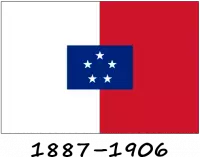Before it was called Vanuatu, the territory was called the New Hebrides during colonial rule. The first to visit these islands were the Spaniards, namely Pedro Fernandez in 1606. However, their stay on the island was short-lived and did not have a significant impact on further history. From 1887 to 1906, the islands were administered by the Anglo-French colony. It was a period of joint protectorate of Great Britain and France, which formally began in 1887. At the same time, a joint naval commission was established to protect the citizens of both countries. During this period, both British and French schools, courts, and other structures existed in the New Hebrides. The flag of that period consisted of two vertical stripes of white and red and a blue rectangle in the center, which, in turn, contained five five-pointed white stars arranged in a trapezoidal shape.

This period laid the groundwork for the formation of the condominium in 1906, when the United Kingdom and France officially established joint administration of the New Hebrides, which lasted until Vanuatu's independence in 1980. The condominium system assumed that both countries had their own administrative, legal and educational systems, and this was reflected in the symbols and flags. Thus, two flags were simultaneously displayed on all government buildings: the French tricolor and the British Union Jack.
During the Second World War, from 1940 to 1944, France was divided into two parts: the German-occupied north and Vichy France in the south, which was formally independent but in fact a collaborationist regime that collaborated with Nazi Germany. The symbolism of the French flag remained virtually unchanged during this period, namely three vertical stripes of blue, white, and red:
- Blue is associated with the revolutionary ideal of freedom and the republican tradition;
- White symbolizes monarchy and royalty;
- Red represents revolution, brotherhood and blood shed for freedom.

Although the symbolism of the flag remained unchanged, the use of the flag in different parts of France had different political meanings. In Vichy France, the Tricolor was used alongside the symbols of the Vichy regime, which sought to emphasize traditional values while cooperating with the Nazi occupiers.
During this period, the flag of resistance under General Charles de Gaulle appeared, which looked like a regular tricolor, but with an additional symbol - the Lorraine Cross. This cross became the emblem of Free France and symbolized the struggle against the Nazi occupation and the collaborationist Vichy regime. The Lorraine cross was chosen for several reasons: it came from the Lorraine region, which symbolized the struggle to regain the lost territories annexed by Germany; it served as a contrast to the Nazi swastika, symbolizing Christian values and opposition to the pagan and totalitarian ideology of Nazism; the cross was easily identifiable by the French population and the Allies, uniting forces in the fight against occupation and collaborationism. After the liberation of France in 1944, the Tricolor again became the only official flag of the country, symbolizing the restoration of republican values and national unity.

The British flag, on the other hand, remained almost unchanged throughout the entire period of the condominium's existence, and even if you place the two variations side by side, it is difficult to immediately notice the differences and it seems that they are exactly the same. However, the flag of 1906-1953 and the flag of 1953-1980 differ in the coat of arms, namely the design of the crown.

In addition, from 1969 to 1980, the United Kingdom and France shared a coat of arms with the following symbols:
- The crossed French flag on the left and the British Union Jack on the right symbolize the joint administration of the New Hebrides;
- The letters "E II R" represent Queen Elizabeth II. The abbreviation "E II R" stands for "Elizabeth II Regina", i.e. "Elizabeth II the Queen". This is a standard designation for British monarchs;
- Letters "RF" stand for "République Française", which means "French Republic". A fascia is a bound bundle of wooden rods, often with an axe. They symbolize power, law, and governance. In ancient Rome, a bundle of fascias was worn by lictors during processions with a judge, and sometimes birch rods were used as punishment to force subjects to obey court orders.






